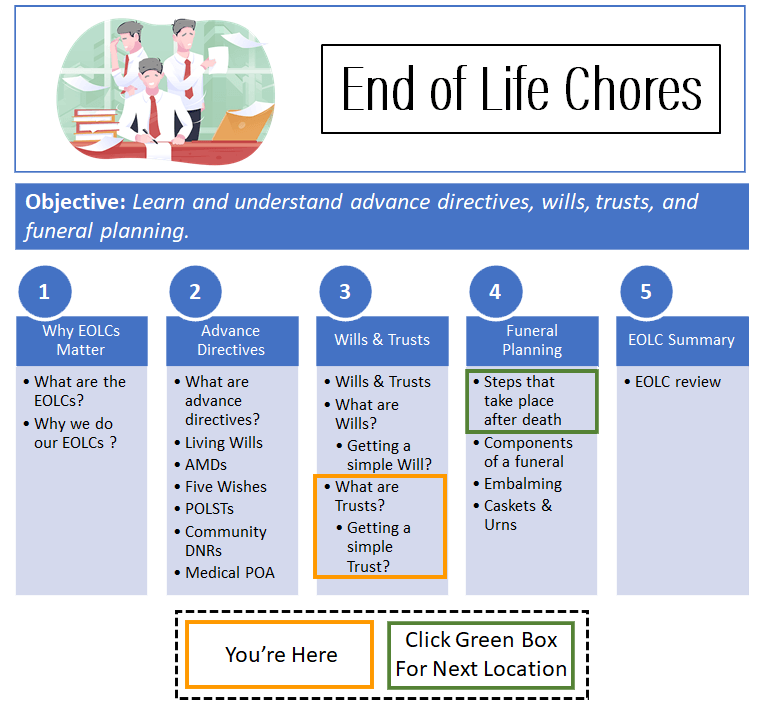Trusts
Click here to see what's on this page.
Ttrusts are legal agreements. They describe how assets are managed to benefit others. These others can be persons or entities unrelated to who owns or owns the original assets or the asset’s current owner(s). The agreement defines how held assets are managed.

Although trusts are often referred to as legal entities, they are better described as having legal authorities. This means they can do the things delineated in the agreement. That might include collecting rent, raising and lowering rental rates, obtaining property insurance, and even selling the property. This means your relationship as a grantor to a trustee is very important. It also means that you must ensure the trust is properly drafted and executed. Always use an experienced lawyer to draft, and always make sure it is properly witnessed and notarized.
History Of Trusts
Trusts have a long history. Wherever there was a legal tradition, issues with property would arise when the owner of that property was not available to manage that property, or that property was considered better managed by another. If a property owner went off to war, for example, what should that person do with their property? If a group of property owners wanted their assets better managed by a combined entity but didn’t want to relinquish ownership, how would they get their assets into a form allowing the combined assets to be managed without their constant consent and signature?
They solve property issues when the property owner wanted those assets managed, or potentially managed by others. Laws can get pretty confusing. For example, is a Trust a legal entity? Can a it enter into contracts? Or is it simply bound to the agreements it enters by the trustee’s authority? Get a lawyer to ensure that trusts are properly created and executed.
Trusts 101
A trust is an agreement. A legal agreement to hold and manage property or assets for the benefit of others. This also creates a legal entity. The grantor is the person setting it up and transferring the assets into the trust. The trustee is the person responsible for managing the assets. The trustee watches over the assets per the agreement.
Once transferred, assets and their ownership belong to the trust. This is done for example, by placing a bank account into the trust by going to your bank and changing the name of the bank account to the name of the trust. Consequently, the asset (the bank account) is now owned by the trust.
Trusts are often the most important component in estate planning. They allow property owners to move assets into a form that can operate when the grantor dies. A common example of a living trust is when a property owner puts a house in the name of a trust, with a child being named as a beneficiary. When the grantor dies, the trustee can transfer the ownership of the house to the child.
Types of Trusts
Always check with your lawyer to determine what types of trusts are best given your needs and given your state laws.
Charitable
These are created to support a charitable purpose or goal. They support annual gifts to a charity. One you choose. This helps a cause you care about. It also lowers taxes on your estate.
Discretionary
These trusts are created for managing and controlling disbursements to beneficiaries. They allow the trustee to distribute income and/or principal among various beneficiaries as the trustee chooses.
Insurance
These are created to manage and control tax issues related to insurance policies. For example, the assets are used to buy a life insurance policy. The policy benefits pass to the trust’s beneficiaries.
Living trusts
As the name implies, these forms are made while living. You maintain full control while you’re living. You can be the grantor, trustee, and beneficiary. Or you can assign someone to be a trustee or appoint other beneficiaries. Upon your death, the trust goes into effect.
Medicaid qualifying trusts
Qualifying forms help plan for Medicaid. To qualify for Medicaid benefits, the government looks at assets. These forms can remove these assets. For example, by placing property in a trust, this asset may not count when a senior applies for Medicaid support to pay for nursing care.
Revocable trusts
Revocable forms are revocable.
Irrevocable trusts
Irrevocable forms are irrevocable. If they are time revocable, the time must lapse. Also, certain tax advantages require that a trust be irrevocable.
Spendthrift trusts
Many people that want to use a trust to pass money to beneficiaries are concerned that the beneficiary may spend the funds in inappropriate ways. For example, the beneficiary may have an addiction issue, special needs, or be in debt. Alternatvely, the grantor may simply want the funds managed in a specific manner. A spendthrift trust creates a trustee that makes funds available to the beneficiary pursuant to the requirements. These don’t allow creditors of the beneficiary to reach the funds.
Support trusts
Support trusts provide a beneficiary’s “education and support.” A trustee is appointed who distributes funds for the education and support of the beneficiary. Trusts of all types may have this provision for one or more beneficiaries. There are also specific Support Trusts. They are created for one or more beneficiaries. The trustee judiciously distributes funds for education and support. This is often done for grandchildren. Or children when the parent does not want their money to move to the child’s wives or children from multiple marriages.
Miscellaneous Information
They can be revocable or irrevocable. When revocable, trusts can be revoked at any time. That creates a lot of flexibility, especially if you’re the trustee. Irrevocable trusts are fixed. Once established, they cannot be changed.
There are two main reasons trusts are used. One is tax avoidance. The goal of minimizing taxes. The second is asset management. Revocable trusts that you control (you’re the Grantor and trustee) require you to report income on your taxes. Because you can revoke it at any time and the assets and income are all for your benefit, it’s no different than if you owned everything. However, assets are not processed in probate. They avoid probate. In other words, distribution occurs outside of probate per the maker’s instructions.
Alternatively, an irrevocable form cannot be changed. These forms generally qualify for their own tax status. Thus, these assets are treated differently for tax purposes. In other words, different from income. For example, the trust itself is responsible for filing and paying taxes. These taxes are based on the trust’s economic activities, not your activities.
Living Trust – A Will Plus A Trust
These are a combo document with both your will (how you want your assets disbursed after death) and a trust (a legal entity that operates without you needing to be alive). People use these because they are simple, and they avoid probate at death. Plus, they allow you to control your assets. Once done you can control assets even when incapacitated.
They must be legal (i.e., properly executed). This requires properly structured assets: moving them to the trust. Often it’s done by renaming the assets from their current name (e.g., John and Mary Doe) to the trusts name (e.g., John and Mary Doe, trustees under John and Mary Doe Living Trust dated [Month]-[Day]-[Year]).
Benefits
- Sidesteps probate at death, including multiple probates if you own property in other states
- Often a better vehicle for managing inheritance than joint ownership
- Alleviates the stress of asset disbursement and creates peace of mind
- Can aggregate or assemble all your assets under one plan
- Also, prevents court control of assets at incapacity
- Ability to change or cancel at any time
- Allow for managing a minor’s or special needs person’s inheritance
- Quicker than probate for distributing assets to beneficiaries
- Assets can remain until you want beneficiaries to inherit
- Great way to manage estate taxes (i.e., wat to reduce or eliminate)
- Quick, easy, and inexpensive to set up and maintain
- Not easy for the beneficiary or heir to contest
- Privacy – wills become public record
- Can appoint a trained or knowledgeable trustee
Common Terminology Seniors Should Know
Trust – A legal entity creating a relationship created by a written document, which requires the named trustee to deal with assets for the benefit of specified beneficiaries.
Trustmaker – Also called a grantor, settlor, or trustor, is the person or company who makes the trust and the person or entity that transfers legal title of specific assets.
Trustee – The person or company who becomes the legal owner of the transferred assets. As trustee they don’t obtain the right to use or enjoy those assets. A trustee administers the trust based on the delineated terms and governing law. The trustee is a fiduciary and thus must manage the trust in the best interests of its beneficiaries.
Beneficiary – the person or company who benefits: has equitable title to the asset(s). A grantor may also be a beneficiary.
Protector – A protector provides some oversight for the trustee. Without a protector the trustee kind of runs their own show. Unless a beneficiary gets wind of a trustee’s bad behavior, a bad trustee can easily run amok. The protector is a person or a company appointed to monitor the activities of the trustee and offer guidance. The guidance is usually based on the changing circumstance of the beneficiaries. The agreement (document) defnes the specific powers, duties and obligations of the protector.
Components
Let’s look at a common structure used frequently in estate planning.
A Living Trust (aka Inter Vivos Trust)
As the name implies, you’re living, and you set up a trust. It can be revocable or irrevocable. Revocable forms are very flexible. In addition, the grantor usually appoints themselves as trustee which means there is no difference between managing the trust and managing their own property. All rights like buying, renting, selling, or giving property remain. The only real difference is that the property is in the trust’s name rather than your name. In addition, these forms also avoid probate.
States have slightly different rules, so make sure your document reflects your State’s rules.
Common characteristics tend to be:
- A document declaring that you’re creating a trust to hold assets for the benefit of yourself and others (children, nephews, nieces, etc.)
- Proper execution (i.e., notarized, witnessed, signature, etc.)
- A list or schedule of trust assets
- Changing the name of the assets to that of the trust (i.e., contacting the bank, brokerage company or insurance company and properly changing the name of the asset to reflect this name).
Always get legal help.
Also, you can select anyone you want to be the trustee. However, you should name alternatives (sometimes known as successor trustee) to take over in the event of the original trustee’s death or incapacity. You also can specify if you will pay fees to the trustee or allow the trustee to recover administration costs.
Living forms also survive your death. For example, if you want to benefit your grandchildren and great-grandchildren you might specify that the trustee make gifts to them until they reach the age of eighteen or finish college. Living trusts, like wills, give you wide flexibility in distributing your property.
You can also gift your property to whoever you want. In addition, you can have your trustee manage assets that produce income (stocks, rental property, etc.) and distribute the income from those assets to whoever you want.
Other Resources
See a sample here.
There’s also a good article is here.
